Registered with the Registrar of Newspapers for India under R.N.I 53640/91
Vol. XXXII No. 23, March 16-31, 2023
Artist Maniam: living in the hearts of many Tamil readers
-- by Subhashini Maniam, suba@maniamselven.com
India was preparing itself for Independence. The time was also coinciding with the need being felt in restoring India’s forgotten culture and heritage. Ramaswamy Krishnamoorthy (1899-1954) (hereafter, Ra Ki) and Thiagaraja Sadasivam (1902-1997) established Kalki in 1941. Providence brought Maniam to Kalki as a young artist. Soon the combination of Ra Ki’s writing and Maniam’s artwork began to create magic among Kalki readers and subscribers. This was possible because of the synchronization of thinking between the two creators Ra Ki and Maniam that developed over a decade. Let us see from the start.
T(handarai) U(mapathy) Subramaniam, my thatha, was born as the eldest son to T(handarai) K(umaraswamy) Umapathy and Gnanambal Umapathy in Mylapore on 26th January 1924. Subramaniam used the sobriquet Maniam in professional circles, and later grew into a highly sought-after artist in the then state of Madras. Having lost his father when he was 20 months old, he grew up in the care of his grandfather T(handarai) C(hengalvaraya) Kumaraswamy (a traditional-Indian medical practitioner of the Thandarai tradition – the Thandarai Vaidyasalai) in Ponnambala Vaidyar Street, Mylapore. Subramaniam first went to the Daadi Vadhiyar School in Nadû Street and later to P(ennathur) S(ubramania Iyer) High School (Branch), located near Mundagakkanni Amman Koil. He was initiated into the world of art through his chittappa T(handarai) K(umaraswamy) Lingayyah, who was only five years older than him. As a child, he watched his uncle Lingayyah and S(undaram) Rajam (a close friend of Lingayyah, and the older brother of Veenai Vidwan Sundaram Balachander) sketching the day-today events in the busy thoroughfares of Mylapore. These artworks of Lingayyah and Rajam influenced Maniam immensely. Lingayyah died at an early age of 16 and Rajam later became a person of high distinction in the world of Carnatic Music further to being a talented artist-painter.
I recollect two childhood incidents of thatha – narrated to me by my appa, T(handarai) S(ubramaniam) Loganathan (better known as Ma Sé) – that go to show the sparks of Maniam’s passion for art as a young boy. As a student in the Dãdi Vadhiyar School, he did a pencil caricature of his teacher, who was fast asleep in the class room after assigning some work to the students. Unexpectedly the inspector of schools walked into the class room and noticed the only student – the young Subramaniam – who seemed to be working intently on his notebook, while rest of the class was busy raising a ruckus. The Inspector collected the Subramaniam’s notebook only to see a pencil caricature of the asleep teacher. That this incident placed Maniam in a tight spot with his teacher is a different story! When Maniam was studying in the P.S. High, he made a clay figure of Rajaji, coinciding with Rajaji’s visit to the school. Little did young Maniam ever imagine then what his future life was going to be!
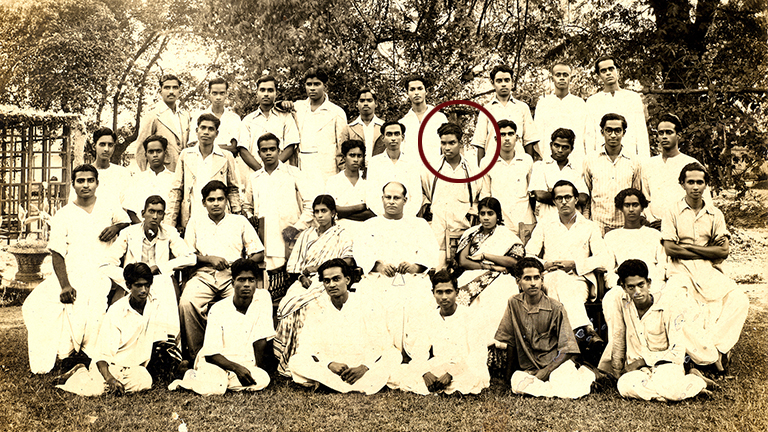 Students and the faculty of Madras school of Arts, 1941. Seen in this picture are: Kalaimagal Swamy, Simha, Chitraleka, Maniam, Silpi, Principal Debi Prasad Roy Choudry, K.C.S. Panikar, Dhanapal and Ramgopal.
Students and the faculty of Madras school of Arts, 1941. Seen in this picture are: Kalaimagal Swamy, Simha, Chitraleka, Maniam, Silpi, Principal Debi Prasad Roy Choudry, K.C.S. Panikar, Dhanapal and Ramgopal.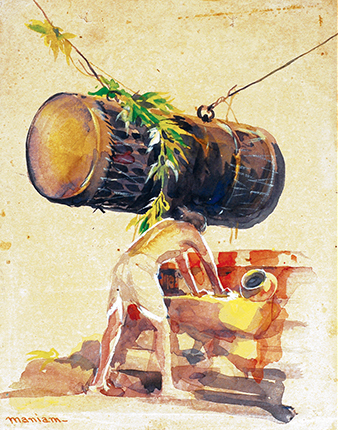 Water colour study of a man grinding sandalwood paste done during his MSA years.
Water colour study of a man grinding sandalwood paste done during his MSA years.Subramaniam joined the Madras School of Art (MSA, presently, the Government College of Fine Arts) in Periamet and trained in fine art when the famous Indian sculptor Debi Prasad Roy Chowdhury (1899-1975) superintended the school between 1929 and 1957. Here as a learner Maniam displayed his spark as an artist of promise. Along with S. Dhanapal, H.V. Ramgopal, Krishna Rao, as colleagues, Subramaniam enjoyed an inspiring companionship as a young artist. While being a student at MSA, in 1941, he got introduced to Ra Ki as a potential candidate artist by S. Rajam’s father Sundaram Iyer. Ra Ki intuitively spotted the talent of Subramaniam and offered a position to join his fledgling Kalki as a full-time artist.
Subramaniam was naturally delighted and astonished with the offer made by Ra Ki and asked him whether he could join after completing his Diploma in Fine Arts from MSA. Probably not to let this talent slip through his fingers, Ra Ki challenged Subramaniam, whether he or his diploma was going to either draw or paint. After much thinking, Subramaniam (signing as Maniam) dropped out of MSA and joined Kalki as a full-time artist. Subramaniam always thought highly and reflected positively of Debi Prasad Roy Chowdhury and Ra Ki as the strongest influences in his life and referred to both of them as his gurus.
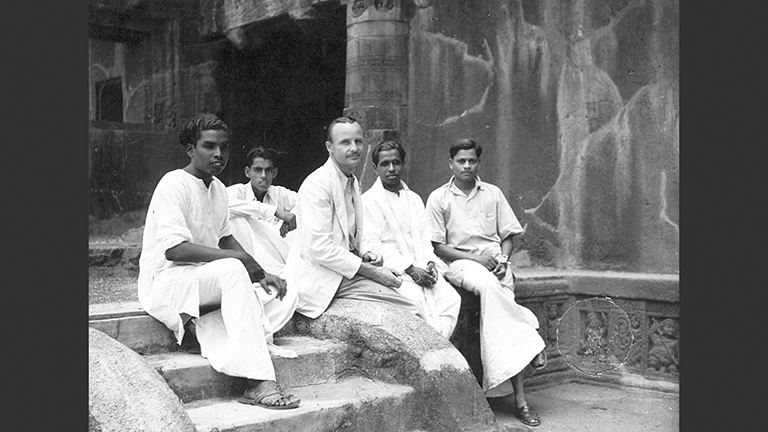 Maniam, Ananthanarayanan, Ellis R. Dungan, Kalki and Nagaraja Rao.
Maniam, Ananthanarayanan, Ellis R. Dungan, Kalki and Nagaraja Rao.In 1944, Ra Ki, the American film director E(llis) R(oderick) Dungan, R.N. Nagaraja Rao (stills photographer), Ananthanarayanan (Kalki staffer) went to see the Ajanta and Ellora artefacts. Maniam, as the artist, had the opportunity to accompany these men; at this time, Dungan was scouting for location for the movie Meera and Ra Ki was writing Sivakamiyin Sabatham. Therefore, Ra Ki preferred to get some seed thoughts from there. This first visit to Ajanta and Ellora enabled the blossoming of the artistic eyes and mind of Maniam. He was lost in the beauty of the Ajanta murals so much, that he stretched his stay there to capture the artistic charm of those artefacts on canvas. On returning to Madras, he contributed his artworks of Ajanta murals to the Kalki Deepavali Malar, 1944, converted as an article titled Ajanta Adisayangal by Ra Ki. Because of the possibility that Maniam could be lost in the meandering caves of Ajanta, Ra Ki has indicated in that article that he felt compelled to leave Ananthanarayanan as an escort for Maniam in Aurangabad to continue his work in Ajanta and Ellora.
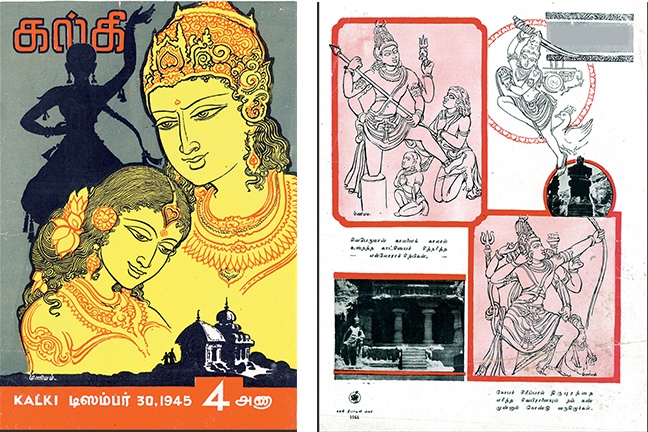
Maniam returned to Madras as an enlightened artist with a new artistic grandeur. Supplemented by keen observations, meticulous historical thoughts were brewing in him. As a young artist, he created tail pieces and Kalki cover illustrations for Sivakamiyin Sabatham, although artist Varma was the principal artist for that novel. Periodical feedback from the Kalki readers, applauding the artworks of young Maniam along with those of Varma gave the assurance and encouragement to hone his uniqueness as Ra Ki’s principal artist. I have heard from my appa and paati that Maniam used to reverentially refer to Ra Ki and Sadasivam often for nurturing him. He held both of them in high esteem for encouraging and providing adequate space for him to blossom into a preferred and liked artist of Madras. Such associations, accelerated by a constant thirst for uniqueness, refined him as a sought-after artist in the next decade of his life.
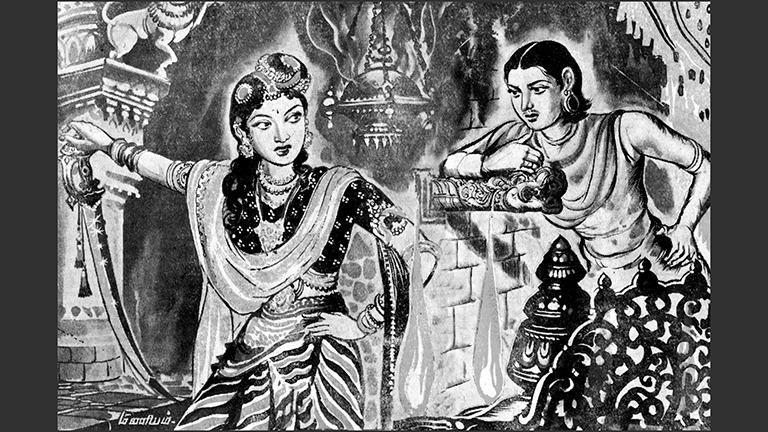 Ponniyin Selvan characters: Nandini and Vandiyathevan, 1950s.
Ponniyin Selvan characters: Nandini and Vandiyathevan, 1950s.When Ra Ki commenced the novel Ponniyin Selvan in Kalki in 1950, Maniam had grown into a talented and full-fledged artist in his own right.
From this time onwards, Maniam explored various means and measures to express his special sense of aesthetics, be it either for design value or for re-imagining scenes of historical past through creative art. Amara Thara was the last serialised story that Maniam and Ra Ki collaborated together for Kalki. Due to the love to re-create visual imagery of Ra Ki’s historical writings on the silver screen, Maniam resigned the full-time position as an artist from Kalki magazine in 1957. With the blessings of T. Sadasivam he embarked on his life as a freelancer.
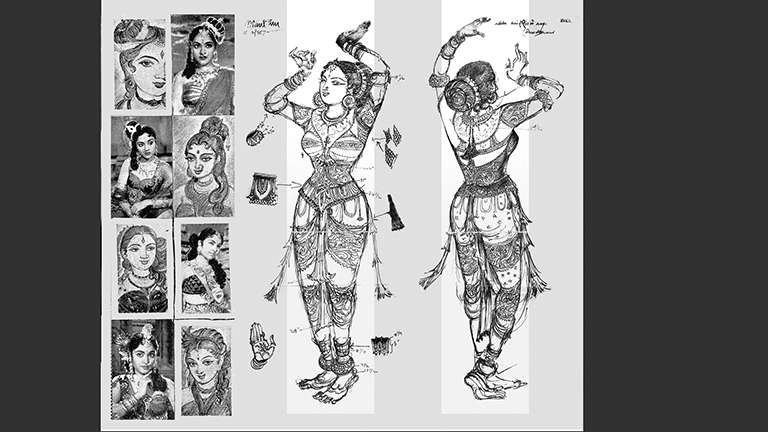 Costume Design & Art direction for Parthiban Kanavu, 1958.
Costume Design & Art direction for Parthiban Kanavu, 1958.He continued to work for Kalki as a freelance artist till his last breath. He served the art director for the movie Parthiban Kanavu, another magnum opus of Ra Ki, produced by Jubilee Films V. Govindarajan, directed by Daasari Yoganand, and released for public viewing in 1960. Maniam handled each of his artworks as a composite mosaic, similar to an enchanting verse composed by a skilful poet, communicating every detail as aesthetically and as powerfully as possible in a 2-D context.
Obsessed with a quest for detail and perfection, he painstakingly created large-size artworks, although finally they were reproduced on the smaller pages of weeklies. He travelled to Hampi, Badami, and the Elephanta Caves, searching for historical relics and deriving inspiration from them, usually accompanied by his wife, Saraswathy, who professionally supported him as an assistant, and even posing as a model when required for him to ‘create’. Saraswathy also enabled him to get homely meals, which she ardently and devotedly prepared with the materials available on site.
Until the end of his short life of 44 years, Maniam grappled with an unquenching thirst to push the boundaries of creative art. In 1968, Maniam had to pass the baton to his only son Loganathan, who rechristened himself as Ma Sé for Maniam Selven (implying ‘son of Maniam’), when Maniam’s body refused to cooperate any further.
May be that was the Divine will to pass on all of Maniam’s aspirations to Ma Se, my appa, at a young age. Appa took his father’s aspirations further and etched a name for himself in the last 50-odd years in fine arts, with a strong conviction of representing his appa through his creative works and quest to learn. Ma Se’s artistic journey continues to set new milestones. Ma Se has carried the Maniam legacy through the barriers of time. Maniam’s passion for delicate art lives in the hearts of many of the present. The year 2023 will mark the start of the year-long birth centenary of Maniam culminating on 26 January 2024. Art lovers of Chennai can eagerly look forward to a visual treat of Maniam’s original and unseen works, which will be displayed at an exhibition to be held in Chennai, at the end of this year.


Comments